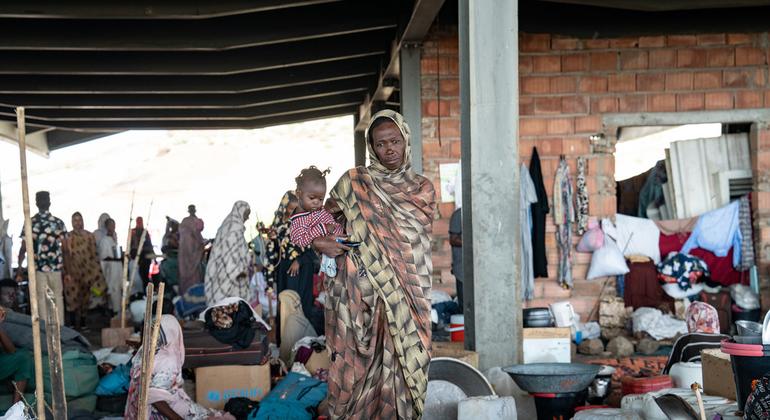Don't Miss Our Holiday offers - up to 50% OFF! & More..


What is civil war in Sudan, destabilizing neighboring countries? – eSHOP24X7
According to the United Nations Agency for Refugees (UNHCR), this war between the Armed Forces of Sudani and the burning entrails, the rapid support force (RSF) is causing a serious humanitarian crisis not only in Sudan, but also in their neighboring countries.
This situation has become even more dangerous for those who were already forced to leave their homes. Every day, thousands of people leave Sudan and resort to other countries in search of security.
There is a very serious situation within the country. Currently, the main center of this war has become the northern region of Darfur, where many citizens have been killed in attacks on the camps of displaced people. The United Nations have requested immediate actions to avoid large -scale famine.
Around 2.5 million people face a serious hunger in Sudan with a population of approximately five million rupees, and this number is expected to increase even more.
The UN spokesman Stephan Dujariq warned that “the rainy season will begin soon and there may be more difficulties in providing human relief due to floods on the main routes. Time is passing.”


1. More than 30 Lakh of people left the country
Currently, Sudan has become the world’s largest displacement crisis.
The United Nations High Commissioner of Refugees, Philipo Grandi, said in February of this year: “One third of the population of Sudan has been displaced. The effects of this horrible and fruitless war feel far beyond the limits of the Sudan.”
Until now, around 38 Lakh of people have escaped from Sudan and have taken refuge in neighboring countries, which has created a great humanitarian crisis. These refugees live in a very insecure situation, they face the lack of food, clean water and medical facilities. The United Nations estimates that by 2025 this number can increase up to 10 Lakhs.
The countries adjacent to Sudan were already fighting with the large number of displaced people, and now the war that began in April 2023 is worsening the situation. In another episode of instability and conflict that date back to Darfur’s crisis of 2003, the 2023 war is connected.
The neighboring countries of Sudan are already giving refuge to a large number of refugees and internal displaced people, but they do not have sufficient funds for humanitarian aid programs. In addition, people who leave Sudan often reach remote areas, which has hindered help agencies to help them.
Most refugees have arrived in Chad and Egypt. Almost six Lakh refugees from Sudani live in Egypt, while more than seven people of people have been registered in Chad so far. The Chad government estimates that by the end of 2025, this number can reach approximately 10 Lakhs.
2. Lack of basic services
When fulfilling the growing demand for health services, education and other basic facilities, the neighboring countries of Sudan are fighting.
According to the United Nations Office (Ocha) for emergency relief, a large number of Sudan refugees have shocked hospitals and health centers in countries such as Chad, Egypt, Ethiopia and South Sudan, where medications, medical goods and health workers are already missing.
This year there is no clarity about the financial assistance of donor countries, which has increased more concern. Because of this, UNHCR has to stop all medical treatment for Sudani refugees of the northern border of Egypt. Now cancer surgery, cardiac operation and long -term diseases are not available, because about 20,000 patients have been affected.


3. DANGER OF DISEASE
The World Health Organization (WHO) issued a warning on the rapid situation of deterioration in Sudan in 2024, saying that current conditions are becoming ideal for disease diseases: health services are almost stagnant, millions of people are forced to live in crowded camps, clean water and bathrooms are not receiving heavy scarce and people are not receiving basic foods and services.
According to apprehension, diseases have begun to spread due to the demolition of health services, and have also reached neighboring countries, where a large number of refugees live. Diseases that can be prevented, there is a risk that the refugee population will seize, since vaccination rates have decreased in the country.
Humanitarian aid organizations have expressed concern about increasing disease cases and the possible crisis, especially in border areas and shelter sites.
4. Increased insecurity
Even before this war, the country of Sudan (Egypt, Libya, Chad, South Sudan, Ethiopia, Arytriya and African Republic Middle) were already fighting their internal problems, such as violent conflicts, hunger and disease.
Violence and instability have increased in border areas due to war in Sudan, and there are reports of cross transmission fighting.
In Chad, violence and insecurity have increased due to the supply of weapons and the presence of armed groups. In South Sudan, a group of militias has been linked to RSF, opposed to the armed forces in Sudan.


5. Increased sexual violence
Sexual violence is being used as a weapon in the War of Sudan, which has increased threat to millions of children. The cruel truth of this violence, and the fear of being prey, is forcing women and girls to abandon their homes and families.
However, when they are internal or cross the border, they have to face even more threats and require medical and mental assistance.
In March, according to UNICEF, girls often reach an informal displacement site, where resources are very low and the risk of sexual violence is high. According to current statistics, around 66 percent of the total boys who were victims of rape are girls.
Children also face difficulties. They often do not share information about sexual harassment due to alleged stigma, which makes them more difficult to obtain help and achieve services.
The surprising thing is that the victim of sexual violence, the age of 16 children was less than five years. Four of them had a year.
6. Economic irruption, increased regional poverty
War has hindered trade routes and economic activities, affecting people’s livelihood in neighboring countries. This has increased poverty and economic difficulties.
In Ethiopia and Egypt, transport costs have increased due to border prohibition and insecurity in commercial routes and economic activities have been reduced through the border. While in Chad and South Sudan, resources have been divided from other important economic areas of the large multitude of refugees.







